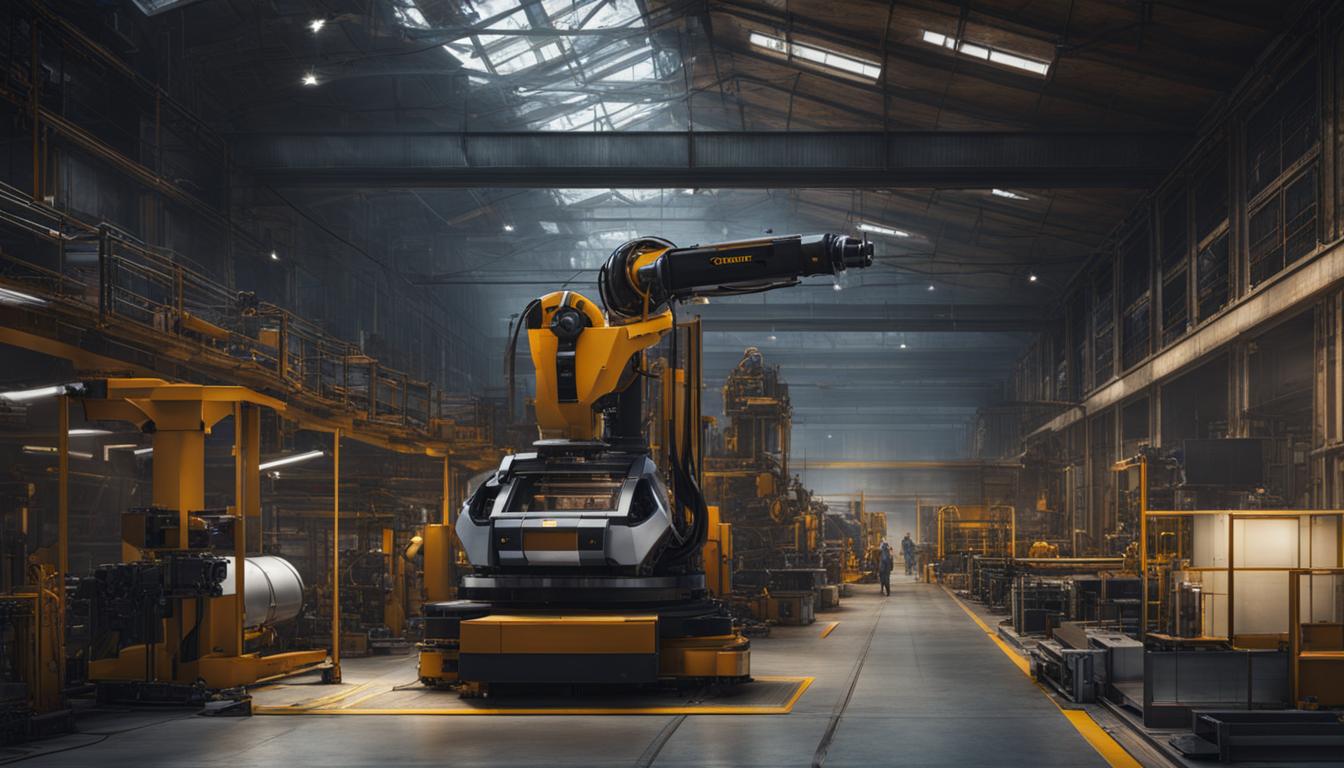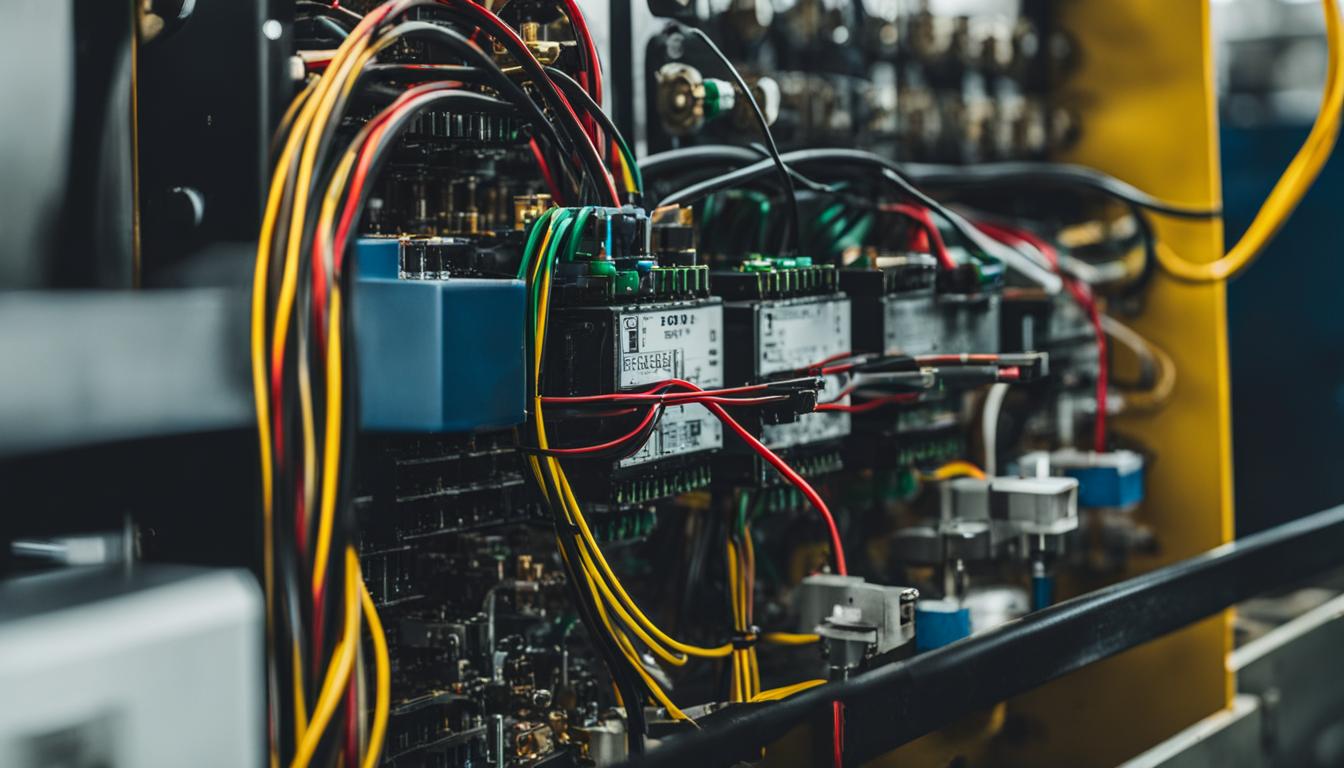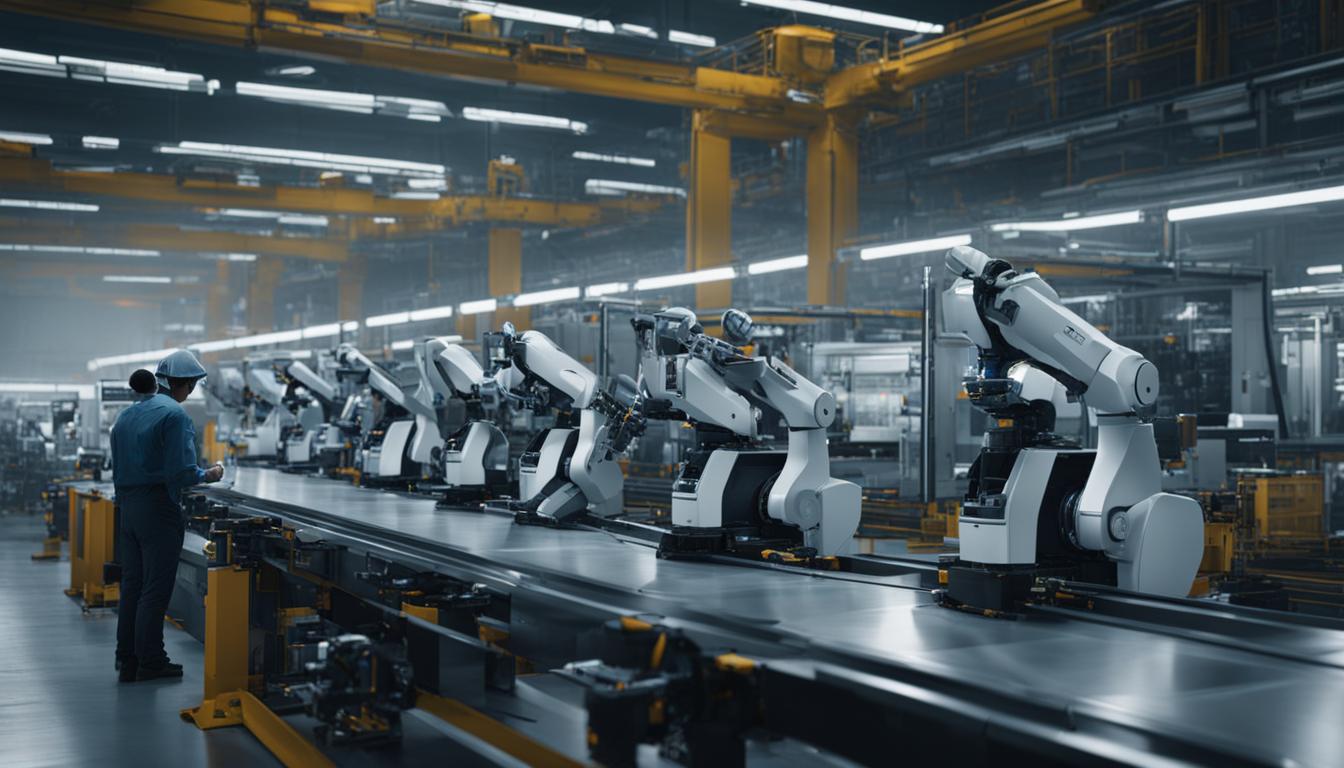Welcome to our comprehensive guide on machine construction and the use of heavy equipment in the construction industry. In this article, we will delve into the world of construction machinery, exploring the different types of heavy equipment, their importance, and the evolution of these powerful machines. Whether you are a construction professional or simply curious about the inner workings of building machines, this article is sure to provide valuable insights and knowledge.
Machine construction involves the utilization of a wide array of heavy equipment to tackle large-scale construction tasks. From earthwork operations to material handling, these machines are specifically designed to handle the demands of the construction industry. Excavators, backhoes, bulldozers, graders, loaders, and many other types of heavy machinery play a crucial role in ensuring the success and efficiency of construction projects.
Key Takeaways:
- Machine construction relies on a variety of heavy equipment to carry out construction tasks efficiently.
- Excavators, backhoes, bulldozers, graders, and loaders are among the commonly used types of heavy equipment.
- Construction machinery includes telescopic handlers, cranes, dumpers, and road construction equipment, among others.
- Heavy equipment offers a mechanical advantage, making construction tasks more efficient and less labor-intensive.
- The evolution of heavy equipment has seen advancements from human power to steam power, diesel power, electric power, and now robotic technology.
Types of Heavy Equipment Used in Construction
When it comes to construction projects, various types of heavy equipment play a critical role in getting the job done efficiently. In this section, we will explore the different types of equipment commonly used in the construction industry.
Excavators

Excavators are incredibly versatile machines that are used for a wide range of tasks, including digging, lifting, and demolition. Equipped with a bucket and hydraulic system, they can handle a variety of materials and operate in different conditions.
Backhoes
Backhoes are essential for excavating trenches and performing loading and unloading tasks. These machines have a digging bucket at the rear and a loader bucket at the front, making them perfect for multiple types of construction work.
Dragline Excavators
For larger excavations, especially underwater, dragline excavators are the go-to machines. With their long reach and powerful lifting capacity, they are used to tackle heavy-duty digging and lifting operations with ease.
Bulldozers
Bulldozers are designed to handle heavy-duty tasks such as removing topsoil layers and lifting soil or rock strata. These robust machines make it possible to clear large areas quickly and efficiently.
Graders
Graders are used for leveling soil surfaces and removing unnecessary layers. They play a crucial role in ensuring that the construction site is properly prepared for further work and that the ground is level and even.
Wheel Tractor Scrapers
Wheel tractor scrapers are used to provide a flattened soil surface. These machines are particularly effective for earthmoving and grading operations, making them vital for shaping the terrain to meet construction requirements.
Trenchers
Trenchers are specialized machines used for excavating trenches. Whether it’s for installing pipelines, cables, or drains, trenchers ensure precise and efficient digging, saving time and effort on the construction site.
Loaders
Loaders are indispensable machines for handling and transporting materials on construction sites. They can load materials onto trucks or dumpers, ensuring a smooth flow of resources and materials throughout the project.
Tower Cranes
Tower cranes are towering structures used for hoisting heavy materials during tall building construction. These machines provide the necessary lifting capacity and reach to enable construction work at great heights.
Pavers
Pavers are used for laying asphalt on roads, creating smooth and durable surfaces. These machines ensure that the asphalt is distributed evenly, resulting in high-quality road construction.
Compactors
Compactors are employed to compact soil or surfaces for a firm foundation. These machines use force and vibration to eliminate air voids, making the soil or surface more stable and ready for further construction.
Telehandlers
Telehandlers are designed to lift heavy materials to required heights. With their telescopic booms and versatile attachments, they can handle a wide range of tasks, making them valuable assets on construction sites.
Feller Bunchers
Feller bunchers are specialized machines used for cutting and gathering trees. They play a crucial role in land clearing and preparing sites for construction projects.
Dump Trucks
Dump trucks are essential for transporting materials on construction sites. With their large capacity, they can efficiently move large volumes of materials from one location to another.
Pile Boring Machines and Pile Driving Machines
Pile boring machines and pile driving machines are used for installing precast piles. These machines ensure that the piles are securely driven into the ground, providing the necessary support for structures and foundations.
Construction Machinery Listings
When it comes to construction projects, having the right machinery is essential to ensure efficiency and productivity. Construction companies rely on a wide range of equipment to tackle various tasks in different environments. From telescopic handlers and backhoe loaders to cranes and aerial platforms, there are numerous machinery options available to suit specific project needs.
Here is a list of some commonly used construction machinery:
| Category | Equipment |
|---|---|
| Telescopic Handlers | |
| Backhoe Loaders | |
| Cranes | |
| Aerial Platforms | |
| Dumpers | |
| Road Construction Equipment | |
| Loaders | |
| Underground Mining Equipment | |
| Waste/Recycling & Quarry Equipment | |
| Dozers | |
| Compressor Equipment | |
| Generators | |
| Oil and Gas Equipment | |
| Marine Equipment | |
| Concrete Equipment | |
| Rollers | |
| Drilling Equipment | |
| Asphalt Machines | |
| Compaction Equipment | |
| Piling Equipment | |
| Spare Parts | |
| Attachments | |
| Construction – Others |
These construction machinery listings cover a wide range of equipment that can be used for various construction projects, whether it’s building roads, excavating sites, or handling heavy materials. Construction companies can choose from these options to find the machinery that best suits their specific project requirements.

Choosing the Right Equipment
With the vast array of construction machinery available, selecting the right equipment for a project can be a daunting task. Considerations such as the project’s scale, terrain, and specific tasks at hand play a crucial role in determining which machinery will be most efficient and effective.
Maintaining and Servicing Machinery
Proper maintenance and servicing are essential for keeping construction machinery in optimal working condition. Regular inspections, routine maintenance, and timely repairs can prolong the lifespan of equipment and ensure safe and reliable operation.
The Importance of Training
Operating construction machinery requires proper training to ensure the safety of workers and prevent accidents. It’s important for operators to receive comprehensive training on the specific equipment they will be operating, including understanding its capabilities, controls, and safety protocols.
Importance and Evolution of Heavy Equipment
Heavy equipment has a long history and plays a crucial role in the construction industry. It holds immense importance in improving efficiency and reducing labor-intensive tasks. The mechanical advantage provided by heavy equipment is a game-changer, as it multiplies the force exerted, making construction tasks more manageable and time-efficient.
The evolution of heavy equipment has witnessed remarkable progress, driven by the constant need to enhance performance and productivity. The industry has transitioned from relying on human or animal power to harnessing the potential of mechanical and technological advancements. Let’s take a closer look at the different stages in the evolution of heavy equipment:
1. Human Power:
In the early days, construction tasks heavily relied on human power. Workers manually performed tasks using basic tools and implements, showcasing the resilience and skill of individuals.
2. Steam Power:
The introduction of steam-powered engines revolutionized the construction industry. Portable steam engines powered heavy equipment and allowed for increased mobility and versatility. This innovation significantly expanded the scope and scale of construction projects.
3. Diesel Power:
With the development of the internal-combustion engine, heavy equipment transitioned to diesel power. Diesel engines offered higher torque and fuel efficiency, enabling the construction industry to undertake more demanding tasks with ease.
4. Electric Power:
The advent of electric power brought forth more sustainable and environmentally friendly alternatives. Electric-powered machines emerged, offering quieter operations, reduced emissions, and improved energy efficiency.
5. Robotic Technology:
As technology continues to advance, the construction industry is exploring the potential of robotic technology in heavy equipment. Robotic systems hold great promise in improving efficiency and productivity, with features such as automation, remote control, and data-driven decision-making.
From humble beginnings of human power to the integration of sophisticated robotic technology, heavy equipment has come a long way. This evolution has shaped the construction industry, enabling it to undertake larger projects, enhance safety measures, and achieve greater precision in construction processes.
By understanding the importance and evolution of heavy equipment, we can appreciate its impact on the construction industry’s growth and development. As technology continues to evolve and new innovations emerge, the future of heavy equipment looks incredibly promising.
Implement and Hydromechanical Work Tools
Heavy equipment is equipped with various implements and hydromechanical work tools to perform specific tasks. These tools enhance the versatility and functionality of heavy equipment, allowing for efficient and precise operations.
Among the many implements and work tools used in construction, we find:
- Auger: Used for drilling holes in the ground, particularly useful in construction projects involving foundations and poles.
- Backhoe: A versatile tool combining a digging bucket and a loader, commonly used for excavation and material handling.
- Bale Spear: Primarily used in agricultural applications to lift and transport bales of hay or straw.
- Broom: Sweeps debris and dirt off surfaces, ideal for cleaning construction sites or roadways.
- Bulldozer Blade: Designed for pushing and leveling soil, rocks, or other materials during grading and earthmoving operations.
- Clam Shell Bucket: Used in excavation and material handling, allows the operator to grab and lift loose materials such as sand, gravel, or debris.
- Cold Planer: Mills and removes asphalt or concrete surfaces to a specified depth during road or pavement construction.
- Demolition Shears: Cuts through various materials, such as steel beams or concrete walls, during demolition or dismantling projects.
- Equipment Bucket: A general-purpose bucket used for various material handling tasks, such as loading and unloading loose materials.
- Excavator Bucket: Designed for digging, trenching, and material handling, available in different shapes and sizes to suit specific applications.
- Forks: Used for lifting and transporting palletized materials, commonly seen in warehouses or construction sites dealing with heavy loads.
- Grapple: Equipped with two or more jaws to grab and secure materials, widely used in forestry, demolition, and waste management.
- Hydraulic Hammer: A powerful tool that delivers high-impact blows to break apart concrete or rocks, often used in construction and quarrying.
- Hydraulics: The system responsible for generating and transmitting power through pressurized fluids, crucial for the operation of heavy equipment.
- Hydraulic Tilting Bucket: Capable of tilting to dump or pour the contents, ideal for tasks that require controlled pouring of materials.
- Landscape Tiller: Prepares the soil by breaking it up and removing debris, commonly used in landscaping and gardening projects.
- Material Handling Arm: An attachment designed for lifting and moving heavy loads, often used in construction and industrial settings.
- Mechanical Pulverizer: Crushes and breaks apart concrete structures or rocks during demolition or recycling efforts.
- Multi Processor: Combines various tools such as shears, crushers, and pulverizers, providing versatile capabilities for material processing and demolition tasks.
- Pavement Removal Bucket: Specific bucket designed to remove asphalt or concrete surfaces during road or pavement maintenance or reconstruction.
- Pile Driver: A heavy-duty piece of equipment used for driving piles into the ground, commonly seen in foundation construction and bridge building projects.
- Power Take-Off: A device that transfers power from a heavy equipment engine to operate different types of auxiliary equipment or attachments.
- Quick Coupler: Facilitates the quick changeover of attachments on heavy equipment without the need for manual connection and disconnection.
- Rake: Used for landscaping and site preparation tasks, such as leveling and removing debris from the soil surface.
- Ripper: A toothed tool attached to the back of a bulldozer, used to break up hard or compacted soil or rock layers.
- Rotating Grab: Provides the ability to rotate and grip materials, allowing for precise positioning or placement, commonly used in material handling operations.
- Sheep’s Foot Compactor: A type of compactor equipped with a drum studded with protrusions resembling sheep’s feet, used for compacting soil or clay layers.
- Skeleton Bucket: Features a grid-like design or open structure, allowing soil or debris to be sifted and separated from larger materials.
- Snow Blower: Removes snow from roads, sidewalks, or other surfaces during winter maintenance operations.
- Stump Grinder: Used to remove tree stumps by grinding them down below ground level, facilitating site preparation and landscaping.
- Stump Shear: Designed to cut tree stumps, facilitating their removal during land clearing or tree removal operations.
- Thumb: An attachment for excavators, providing additional versatility and control for grabbing and manipulating objects.
- Tiltrotator: Enables excavator attachments to tilt and rotate, enhancing precision and maneuverability.
- Trencher: Digs trenches of different depths and widths for various underground construction projects, such as utility installations or drainage systems.
- Vibratory Plate Compactor: A compacting tool used to achieve a denser soil or gravel surface by applying high-frequency vibrations.
- Wheel Saw: Attaches to heavy equipment and is used to cut through hard surfaces like concrete or asphalt, mainly for road construction or repair.
These implements and work tools are essential for completing construction tasks efficiently and effectively. They allow operators to tackle a wide range of projects with precision, improving overall project productivity and quality.
Conclusion
In conclusion, machine construction and the use of heavy equipment are fundamental aspects of the construction industry. The availability of a wide range of heavy equipment empowers construction companies to efficiently undertake various tasks, ultimately improving productivity in the sector. As the industry continues to progress, advancements in technology, such as the integration of robotic systems, are anticipated to significantly enhance the efficiency and capabilities of heavy equipment.
With continuous development and innovation, the future of machine construction appears promising. The construction industry is poised to further embrace technological advancements, enhancing efficiency and productivity across projects of all sizes. The use of heavy equipment in construction will undoubtedly play a crucial role in driving the growth and success of the sector.
As we look ahead, efficiency and productivity will remain key focal points for construction companies. By leveraging cutting-edge technologies and optimizing the utilization of heavy equipment, the industry will continue to thrive, meeting the demands of an increasingly complex and dynamic construction landscape.
FAQ
What is machine construction?
Machine construction refers to the use of heavy equipment in the construction industry to handle large-scale construction tasks.
What types of heavy equipment are used in construction?
Some common types of heavy equipment used in construction include excavators, backhoes, bulldozers, graders, loaders, and many others.
How do construction companies choose the right equipment for their projects?
The selection of equipment depends on the size of the project and its specific requirements.
What are some examples of heavy equipment used in construction?
Examples include excavators, backhoes, bulldozers, graders, loaders, tower cranes, pavers, compactors, dump trucks, and pile driving machines, among others.
What is the importance of heavy equipment in the construction industry?
Heavy equipment offers a mechanical advantage, making construction tasks more efficient and less labor-intensive.
How has heavy equipment evolved over time?
Heavy equipment has evolved from human or animal power to portable steam-powered engines, internal-combustion engines, and electric-powered machines.
What are some implement and hydromechanical work tools used with heavy equipment?
Examples include augers, backhoes, brooms, bulldozer blades, clam shell buckets, cold planers, demolition shears, excavator buckets, grapple attachments, and hydraulic hammers, among others.
What are some listings for construction machinery?
Construction machinery listings include telescopic handlers, backhoe loaders, cranes, aerial platforms, dumpers, road construction equipment, loaders, underground mining equipment, and many others.
What is the future of machine construction?
With advancements in technology, such as robotic systems, the efficiency and capabilities of heavy equipment are expected to further improve in the future.




